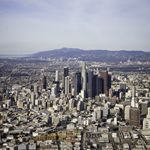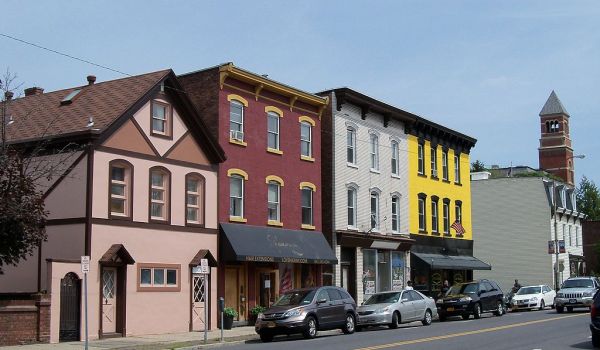London has the Gherkin.
Kuala Lumpur, the Petronas Towers.
Dubai, the Burj Al Arab.
And Shanghai has, like, all of Shanghai.
This blog could go on and on, but let’s instead get to the point of this post — or rather, the lack of points.
Which is that, unlike the contemporary edifices referenced above, the roofs of Los Angeles’ modern high-rise buildings are almost universally flat. Their highest reaches are 180-degrees, like some poured concrete prairie. At a circus, L.A.‘s rooftops would be a safety net, not the aerialists. At the barbershop, a crew cut or high-top fade.
Meanwhile, it’s like the rest of the world is out spraying up liberty spikes. What gives, City of Angels?

“I think it’s absolutely a valid question to ask, ‘Why are there no Chrysler Buildings in Los Angeles?’” says Emily Gabel-Luddy, head of the Department of City Planning’s Urban Design Studio. “The Chrysler Building — as everyone famously knows — along with the Empire State Building, have these marvelously expressive tops to them that serve as landmarks and iconic architecture in lots of places.”
The answer, Gabel-Luddy and other planners and an engineer explain, can be found by reading Chapter V of the Los Angeles Municipal Code, “Public Safety and Protection.” Inserted in 1974, Sec. 57.118.12 of the code is titled, “Emergency Helicopter Landing Facility” and begins: “Each building shall have a rooftop emergency helicopter landing facility in a location approved by the Chief.” The code mandates these helipads be 50’x50’ and include a 25’ safety buffer.
The architectural end result is that like a balloon with a pinprick, L.A.‘s high-rises have gone flat. There is one prominent Downtown L.A. exception to the flats — Los Angeles City Hall. This stately white beacon, with its ziggurat top and its Lucky Lindbergh search lamp, was completed in 1928 and designed by John Parkinson, Albert C. Martin and John C. Austin.
The 27th floor of City Hall features a panoramic observation deck. A tight walkway squares around the high-ceilinged Tom Bradley Tower Room, which is open to the public. One wall quotation reads: “The city came into being to preserve life, it exists for the good life.” Here, Michael Woo greets a visitor. Woo is an urban planner, L.A. City Planning Commissioner, and former City Councilmember. He’s no newcomer to pondering ways to spice up the skyline. “It’s something that I’ve thought about for at least twenty years,” Woo says. “Just because it was so obvious that Los Angeles lacked the kind of dazzling architectural tops that you can see in other cities.”
Like the other people interviewed for this post, Woo is by no means coming out against public safety. On the contrary, Woo et al. are interested in a more thorough discussion about whether it’s possible for L.A. edifices to both possess effective emergency ingress and egress and creative crowns.
“This is a good example of a law that’s been on the books for many years, but nobody has questioned it,” Woo says. “And yet it has a big impact on the way people think of not just Downtown architecture, but also the whole image of the city.”
Nate Wittasek is an engineer who heads consultant giant ARUP’s Los Angeles Fire Engineering Group. Wittasek, reached via email while in Dubai, indicates that technological innovation could eventually make a difference. Wittasek says Emergency Evacuation Elevator Systems (EEES), already in use in England and Hong Kong and arriving to the U.S., could cut building evacuation times in half.
“A key challenge, of course is that building occupants have been told for a very long time not to use elevators in light of historical dangers,” says Wittasek. EEES have been designed to overcome the problems that had made using elevators to assist in evacuation infeasible.”
There’s also the matter of whether it’s counterintuitive for people to head to the roof during a disaster; and questions remain about how helpful – or dangerous – a helicopter is in a smoky, dense urban environment.
At City Hall, from high on that 27th floor, various flat roofs are visible in the near and distant civic center. Red triangles with the letter “H” have been painted on buildings’ white tops. From a birds’-eye-view, the city’s showcase edifices look like they are labeled for hydrogen gas storage. Perhaps the low-rises could receive different letters, so Google Earth’ers could play satellite Scrabble.

Sitting in the Bradley Room, Woo, from the Planning Commission, is asked if architects make proposals that flaunt Sec. 57.118.12? “No,” Woo says. “They don’t even bring it up. It’s interesting, nobody even asks for a variance.”
So then, no chance a greater movement is afoot to revisit the defacto ban? “The reaction I’ve gotten from architects,” Woo says, “is that many view it as a low priority – not something they really care about. Or, if they are going to quarrel with building officials in the City of L.A., there are other things they care about more than this issue.”
If emergency safety concerns begat bland heads on the body architect, then perhaps fire safety solutions will lead a flair revival. Half a world away, in Dubai, with its hallucinatory palms and world map islands, Wittasek, of ARUP, offers a conclusion.
“From an engineering perspective,” he says, “I would simply note that if one has limited resources to work with, and there is a choice between building a half-million-dollar helipad that would likely be used infrequently, if ever, and designing an enhanced vertical transportation system that would benefit far more building occupants, including people with disabilities, it seems to make sense to pursue the latter solution, even in the face of cultural and jurisdictional challenges.”
Next Week: Where Have All the Mariachis Gone? A visit to a Boyle Heights hotel and nearby gazebo in search of the wandering musicians.
All photos © 2008 Steven Rowell




_920_518_600_350_80_s_c1.jpg)











